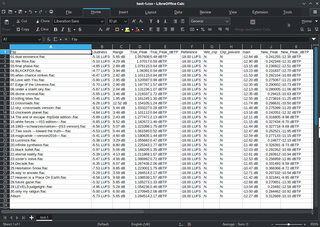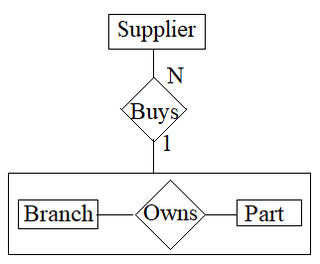Related Research Articles

A spreadsheet is a computer application for computation, organization, analysis and storage of data in tabular form. Spreadsheets were developed as computerized analogs of paper accounting worksheets. The program operates on data entered in cells of a table. Each cell may contain either numeric or text data, or the results of formulas that automatically calculate and display a value based on the contents of other cells. The term spreadsheet may also refer to one such electronic document.

Lotus Improv is a discontinued spreadsheet program from Lotus Development released in 1991 for the NeXTSTEP platform and then for Windows 3.1 in 1993. Development was put on hiatus in 1994 after slow sales on the Windows platform, and officially ended in April 1996 after Lotus was purchased by IBM.
Online analytical processing, or OLAP, is an approach to answer multi-dimensional analytical (MDA) queries swiftly in computing. OLAP is part of the broader category of business intelligence, which also encompasses relational databases, report writing and data mining. Typical applications of OLAP include business reporting for sales, marketing, management reporting, business process management (BPM), budgeting and forecasting, financial reporting and similar areas, with new applications emerging, such as agriculture.

Comma-separated values (CSV) is a text file format that uses commas to separate values. A CSV file stores tabular data in plain text, where each line of the file typically represents one data record. Each record consists of the same number of fields, and these are separated by commas in the CSV file. If the field delimiter itself may appear within a field, fields can be surrounded with quotation marks.

A join clause in the Structured Query Language (SQL) combines columns from one or more tables into a new table. The operation corresponds to a join operation in relational algebra. Informally, a join stitches two tables and puts on the same row records with matching fields : INNER, LEFT OUTER, RIGHT OUTER, FULL OUTER and CROSS.
The SQL SELECT statement returns a result set of records, from one or more tables.

An OLAP cube is a multi-dimensional array of data. Online analytical processing (OLAP) is a computer-based technique of analyzing data to look for insights. The term cube here refers to a multi-dimensional dataset, which is also sometimes called a hypercube if the number of dimensions is greater than three.
An SQL INSERT statement adds one or more records to any single table in a relational database.
Essbase is a multidimensional database management system (MDBMS) that provides a platform upon which to build analytic applications. Essbase began as a product from Arbor Software, which merged with Hyperion Software in 1998. Oracle Corporation acquired Hyperion Solutions Corporation in 2007. Until late 2005 IBM also marketed an OEM version of Essbase as DB2 OLAP Server.

Javelin Software Corporation (1984–1988) was a company in Cambridge, Massachusetts, USA, which developed an innovative modeling and data analysis product, also called Javelin, and later Javelin Plus. Seen as the successor technology to spreadsheet software in reviews of the time, and rival to the then-dominant Lotus 1-2-3, Javelin won numerous industry awards, including beating Microsoft's new Excel for the InfoWorld Software Product of the Year award.
Multidimensional Expressions (MDX) is a query language for online analytical processing (OLAP) using a database management system. Much like SQL, it is a query language for OLAP cubes. It is also a calculation language, with syntax similar to spreadsheet formulae.
An entity–attribute–value model (EAV) is a data model optimized for the space-efficient storage of sparse—or ad-hoc—property or data values, intended for situations where runtime usage patterns are arbitrary, subject to user variation, or otherwise unforeseeable using a fixed design. The use-case targets applications which offer a large or rich system of defined property types, which are in turn appropriate to a wide set of entities, but where typically only a small, specific selection of these are instantiated for a given entity. Therefore, this type of data model relates to the mathematical notion of a sparse matrix. EAV is also known as object–attribute–value model, vertical database model, and open schema.

In database management, an aggregate function or aggregation function is a function where multiple values are processed together to form a single summary statistic.
A GROUP BY statement in SQL specifies that a SQL SELECT statement partitions result rows into groups, based on their values in one or several columns. Typically, grouping is used to apply some sort of aggregate function for each group.

Numbers is a spreadsheet application developed by Apple Inc. as part of the iWork productivity suite alongside Keynote and Pages. Numbers is available for iOS and macOS High Sierra or newer. Numbers 1.0 on Mac OS X was announced on August 7, 2007, making it the newest application in the iWork suite. The iPad version was released on January 27, 2010. The app was later updated to support iPhone and iPod Touch.
Microsoft SQL Server is a proprietary relational database management system developed by Microsoft. As a database server, it is a software product with the primary function of storing and retrieving data as requested by other software applications—which may run either on the same computer or on another computer across a network. Microsoft markets at least a dozen different editions of Microsoft SQL Server, aimed at different audiences and for workloads ranging from small single-machine applications to large Internet-facing applications with many concurrent users.

SOFA Statistics is an open-source statistical package. The name stands for Statistics Open For All. It has a graphical user interface and can connect directly to MySQL, PostgreSQL, SQLite, MS Access (map), and Microsoft SQL Server. Data can also be imported from CSV and Tab-Separated files or spreadsheets. The main statistical tests available are Independent and Paired t-tests, Wilcoxon signed ranks, Mann–Whitney U, Pearson's chi squared, Kruskal Wallis H, one-way ANOVA, Spearman's R, and Pearson's R. Nested tables can be produced with row and column percentages, totals, standard deviation, mean, median, lower and upper quartiles, and sum.

XLeratorDB is a suite of database function libraries that enable Microsoft SQL Server to perform a wide range of additional (non-native) business intelligence and ad hoc analytics. The libraries, which are embedded and run centrally on the database, include more than 450 individual functions similar to those found in Microsoft Excel spreadsheets. The individual functions are grouped and sold as six separate libraries based on usage: finance, statistics, math, engineering, unit conversions and strings. WestClinTech, the company that developed XLeratorDB, claims it is "the first commercial function package add-in for Microsoft SQL Server."
LibreOffice Calc is the spreadsheet component of the LibreOffice software package.
Data Analysis Expressions (DAX) is the native formula and query language for Microsoft PowerPivot, Power BI Desktop and SQL Server Analysis Services (SSAS) Tabular models. DAX includes some of the functions that are used in Excel formulas with additional functions that are designed to work with relational data and perform dynamic aggregation. It is, in part, an evolution of the Multidimensional Expression (MDX) language developed by Microsoft for Analysis Services multidimensional models combined with Excel formula functions. It is designed to be simple and easy to learn, while exposing the power and flexibility of PowerPivot and SSAS tabular models.
References
- ↑ "United States Trademark Serial Number 74472929". 1994-12-27. Retrieved 2022-03-23.
- ↑ Jelen, Bill; Alexander, Michael (2006). Pivot table data crunching . Indianapolis: Que. pp. 274. ISBN 0-7897-3435-4.
- ↑ Gartung, Daniel L.; Edholm, Yorgen H.; Edholm, Kay-Martin; McNall, Kristen N.; Lew, Karl M., Patent #5915257 , retrieved 2010-02-16
- ↑ Darlington, Keith (2012-08-06). VBA For Excel Made Simple. Routledge (published 2012). p. 19. ISBN 9781136349775 . Retrieved 2014-09-10.
[...] Excel 5, released in early 1994, included the first version of VBA.
- ↑ Shah, Sharanam; Shah, Vaishali (2008). Oracle for Professionals - Covers Oracle 9i, 10g and 11g. Shroff Publishing Series. Navi Mumbai: Shroff Publishers (published July 2008). p. 549. ISBN 9788184045260 . Retrieved 2014-09-10.
One of the most useful new features of the Oracle Database 11g from the SQL perspective is the introduction of Pivot and Unpivot operators.
- ↑ "LibreOffice Calc and Pivot table with empty cells". StackOverflow . 2021-06-17. Retrieved 2021-06-17.
- ↑ "Functionality request for PIVOTTABLE". LibreOffice bugs. 2012-03-19. Retrieved 2021-06-17.
- ↑ Dalgleish, Debra (2007). Beginning PivotTables in Excel 2007: From Novice to Professional. Apress. pp. 233–257. ISBN 9781430204336 . Retrieved 18 September 2018.
- ↑ "Busy Developers' Guide to HSSF and XSSF Features". poi.apache.org. Retrieved 2022-12-09.
- ↑ "Pivot Tables".
- ↑ "Create & use pivot tables". Docs Editors Help. Google Inc. Retrieved 6 August 2020.
- ↑ "iWork update brings major changes to Mac, iPhone, and iPad apps". Macworld. Retrieved 2021-09-28.
- ↑ "PostgreSQL: Documentation: 9.2: tablefunc". postgresql.org. 9 November 2017.
- ↑ "CONNECT Table Types - PIVOT Table Type". mariadb.com.
- ↑ "FROM clause plus JOIN, APPLY, PIVOT (T-SQL) - SQL Server".
- ↑ "pandas.pivot_table" . Retrieved 21 November 2023.
- ↑ dplyr and Pivot Tables.
- ↑ Pivoting.
- ↑ "pivottabler".